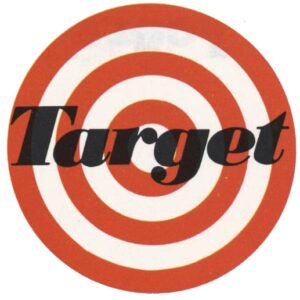But it’s just two circles. That’s the new logo? It’s just a simple shape – my toddler could draw that.
When Target rolled out it’s logo design in 1968, it didn’t turn any heads, but the $50,000 they spent on it was unprecedented. The old logo, basically a red bulls-eye with three red circles was updated – to have fewer circles. While you could argue that it’s an improvement, why would cost so much to get from one to the other? Today, companies are spending figures 10 or 20 times that, and most people I talk to always scratch
their heads when they look at the result. Which brings up a good question:
What is a logo worth?
If companies are willing to invest massive sums in a simple shape, then they must get that money back, right? Not exactly. Michael Bierut, the founder of Design Observer, describes logos as ‘empty vessels’ that hold brand value accrued over time. In essence, logos, design and branding don’t create something that isn’t there, and they certainly won’t make a company suddenly profitable. However, they do help hold all the work, goodwill and reputation in one identifiable place. Something that people recognize. So, what makes one vessel better than another? What makes a vessel worth $50,000? And why would anyone spend that much without any guarantee of return?

Risk and Permanence.
Because logos are meant to last, logo designers must be able to see the future. They must consider not just what messages this vessel will carry, not just today, but all the possible directions this entity might go in the future. What might the market look like in five years? A logo design also needs to be seen from every single perspective, in different places and at different times. And all of that value has to fit into that vessel. Imagine launching a new product line and your logo conflicts with it. Or that it turns out your graphic is really similar to something you don’t want to be associated with.
What these companies are paying for is more than the creative expertise and decision making, but thorough testing and experimentation to make sure that they don’t make a mistake that they have to live with for the next twenty years. They don’t simply go from one shape to another without considering dozens of drafts with slight variations that you won’t see. When you’re the size of Pespico $1 million is insignificant compared to the potential damage to your brand if you make a slight misstep and haven’t taken everything into consideration.
But what if we’re not the size of Pepsico? How do we know how much to spend on design?
There’s no doubt that good design can help you communicate your message better. A well-constructed campaign can cause people to stop and take notice and, if done really well, understand the message you’re trying to get across. Getting to this point is important for any small to medium size business but spending extra in testing and experimentation for the sake of risk mitigation is just a question of how much is at risk. What’s in the vessel and what could we possibly lose by trying change vessels? It’s not a question of much is a logo worth, but how much is it worth to avoid remaking it.
The cost of remaking a logo
- The biggest cost associated with remaking a logo is simply this: you lose brand recognition the day you remake a logo. If logos are vessels, then old logos are always full (of good or bad reputation) and new one’s are always empty.
- The costs of research, design and implementation.
- The numb viewer effect. When you make a new logo, your audience takes this as an indication that something about your business has changed. If you are constantly changing, this will erode any sense of stability in your brand. In short – if you can’t appear to figure out your identity, consumers won’t bother trying understand who you are either.

